Author:
Prof.Dr.Khan Singh Amera M.D. (Hom.)
Professor and head, Deptt.of FMT
Dr.MPK Homoeopathic Medical College, hospital and research center, Jaipur
ABSTRACT
| Establishment of the individuality of a living / dead/ known / unknown person required in all medico legal cases for exact fixation of personality. Following data are helpful which are considered surest sign to establish individuality of the of a living / dead/ known / unknown person- Race & religion, Sex, Age (Determination of age by ossification of bones) Skeleton Hair, Deformities( Congenital &Acquired ),Tattoo marks, Clothing, Ornaments, Hand writing, Speech and voice, Tricks of manner and habits, Photographs, Dactylography (finger printing), DNA finger printing. |
- INTRODUCTION:
Establishment of the individuality of a living / dead/ known / unknown person required in all medico legal cases for exact fixation of personality. It is based on certain physical characteristics or scientific medical data. Identification is made by the medical officer, police officer &relatives.
Importance of identification: For fixation of identity, for medico legal cases during injury, for disputed case of sex & age, in criminal cases, sexual offence, assault, suicidal, homicidal, accidental cases, missing of children, missing of adult with lost memory, exchange of new born babies in hospital, to secure unlawful possession of property by other person, Insurance claim, absconding soldiers, accident in railway, aero plane, ship, fire, explosion, In case of suspected death of unknown person. so this is considered to be surest sign of identity of an individual.
- DATA REQUIRED FOR IDENTIFICATION
For identification following data are helpful which are considered surest sign to establish individuality of a living / dead/ known / unknown person.
- Race & religion: It can be determined by skin complexion, color of Eyes,
ornaments, nose ring aperture, ear rings along helix, tattoo mark, vermilion on
head, circumcision etc.
- Brown skin in Indian, Fair in European, black in Negroes, dark & brown color of iris in Indian, Blue or Grey in Europeans.
- Hindu females- Have vermilion (cinnabar) on head, silver toe ornaments, Tattoo Mark, Nose ring aperture in left Nostril, Ear rings along helix.
- Hindu- Hindu males -are not circumcised.
- Muslim females -Have several opening along helix, Nose ring in septum only
- Muslim-Muslim males -are circumcised.
- Sex: It can be determined by Chromatin body and
Davidson Body
- Chromatin body: in male- 0 to 4, in female- 20 to 80.
- Davidson Body: in male- Absent, In female- Davidson Body present up to 6%.
- Quinacrine positive Bodies: in Male- 45 to 80%, In Female- 0 to 4%.
- Age: The age of an individual can be determined from teeth and ossification of bones.
The alveolar cavities of teeth formed around third or fourth month of intra uterine life.
- Temporary teeth– These are 20 in numbers, calcification of root completed within 1.5 to 3 year
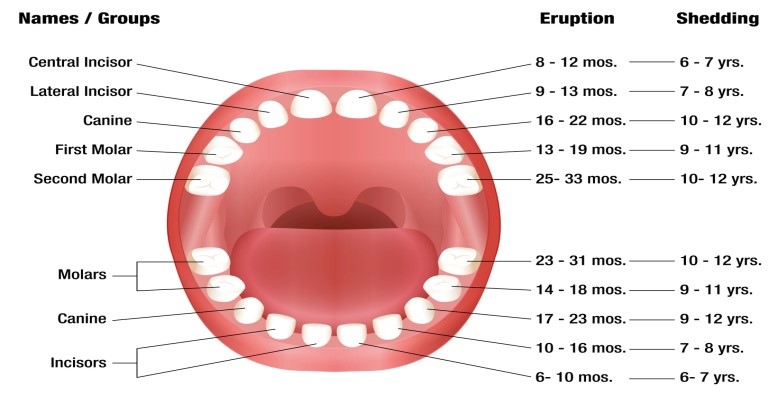
- Permanent teeth– These are 32 in number , eruption & calcification completed of permanent teeth-6 yrs. to – 25 yrs.
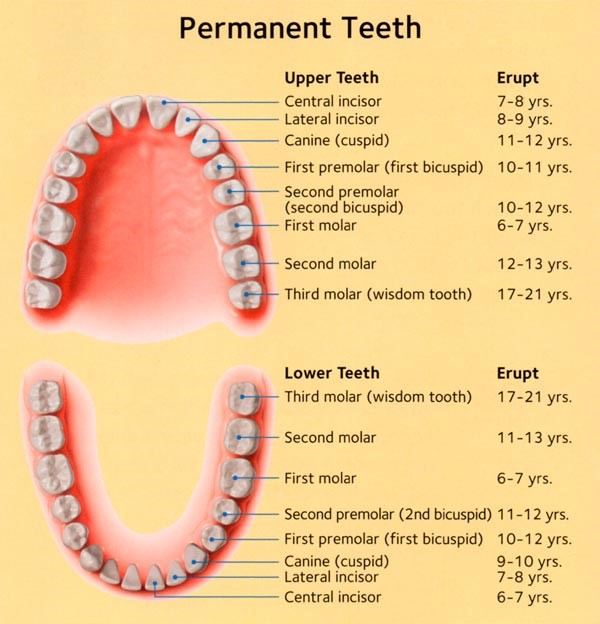
- Determination of age by ossification of bones: The pieces of sternum fuse with one another from below side upward in the age of 14 to 25 years.
- Lower end of epiphysis in humerus fuse at the age of 14 to 16 years.
- Lower end epiphysis in ulna fuse at the age of 17 to 18 years.
- Calcaneous bone fuse at the age of 14 to 16 years.
- Lower end of femur fuse at the age of 18 to 19 years.
- Skeleton- The cephalic Index or Index of breadth it is measured by calipers
- CI. = 70 to 75 in Aryans & Negroes Long headed.
- CI. = 75 to 80 in Europeans& Chinese Medium headed.
- CI. = 80 to 85 in Mongolians. Short head
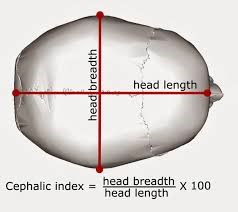
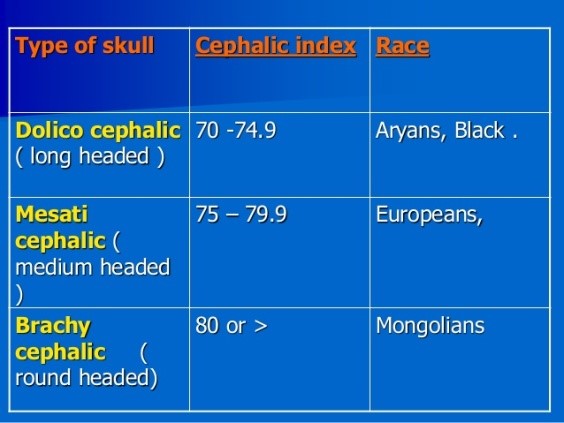
- Hair: Hair are important in crime investigation. Hair consists of bulb or root and a shaft, in human head hairs, Barr bodies are found. Proportion of hair follicles in female-29 +_5 % and in male 6 +_2 % found.
Diameter of hair is different according to age:
- 12 days- 0.024 mm ,6 months-
0.036 mm
- 15 years- 0.053 mm, Adults- 0.07 mm.
Colour of hairs:
- Black- thin in Indians,
- light brown or reddish Fair in Europeans,
- Wooly in Negroes.
- Deformities:
- Congenital:-Moles, Harelip, cleft palate, Squint, Super Numeracy finger/ Toe, Webbed Finger toe, Tulips’
- Acquired:- Amputation, Callosities, Fracture < Non fusion, Mal fusion, occupation Mark, scar due to Accident/ Operation, Teeth;- Artificial/ Denture. In Adult Artificial teeth do not accommodate more than 28.
- Tattoo marks: Tattoo marks are designs made in the skin by multiple small puncture wounds with needles dipped in coloring matter. Most of the marks are found on the arms, for arms and chest. Useful in identification, Religion, God of worship, Social status, indicate country, region. They reflect history, occupation, sex interest.
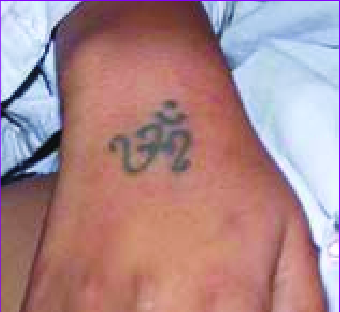
- Clothing: The clothing may indicate the social status to a certain extent, any variety of uniform is very valuable for identification. Clothing may also indicate the occupation. Bullet holes, tears, cuts or any marks found on the clothing may give information regarding the cause and manner of death.
- Ornaments– The design of the ornaments varies from region to region.
- Hand writing: Handwriting is characteristic of the individual, especially if it is written rapidly.
- Speech and voice: Certain peculiarities of speech become more evident when the individual is talking excitedly e.g. – Stammering, stuttering, lisping and nasal twang. Speech is also affected by nervous disease. Any person can alter his voice at will. Tape recording is useful.
- Tricks of manner and habits: They are hereditary e.g. – left handedness, jerky movement of shoulders or muscles of face is the individual characteristic.
- Photographs: by photograph person is identified easily, it is help full for identification of missing person.
- Dactylography (finger printing)- Finger prints are impressions of patterns formed by the papillary or epidermal ridges on the finger tips. Papillary ridges and pores of sweat glands on finger tips are absolutely constant and persist through out one’s life from birth to death. So this is considered to be surest sign of identity of an individual.

There are 4 types of papillary ridges on the finger tips.
Arch form about 6-7 %, Loop form about 67%, Whorl form about 25%, Composite form about 1 to 2% .
- DNA finger printing (Dr. Alee Jeffrey developed it 1985)- DNA finger printing is a technique in which DNA dividing into fragments chemically which form a unique pattern and then matching that “Identity Profile” with the suspected blood specimen. in this method molecules are separated by Gale electricity phoresis. Transfer molecules in Nylene membrane & membrane placed in the x-ray cassette holder along with x-ray film. And then take x-ray printing. The series of bands are seen on the film it is called “Auto rod” which represent the DNA finger print of that individual from whom the DNA had been obtained. The pattern of band is unique to each individual. The band pattern produced on x-ray plate produces a strip of 32 to 40 dark bands.
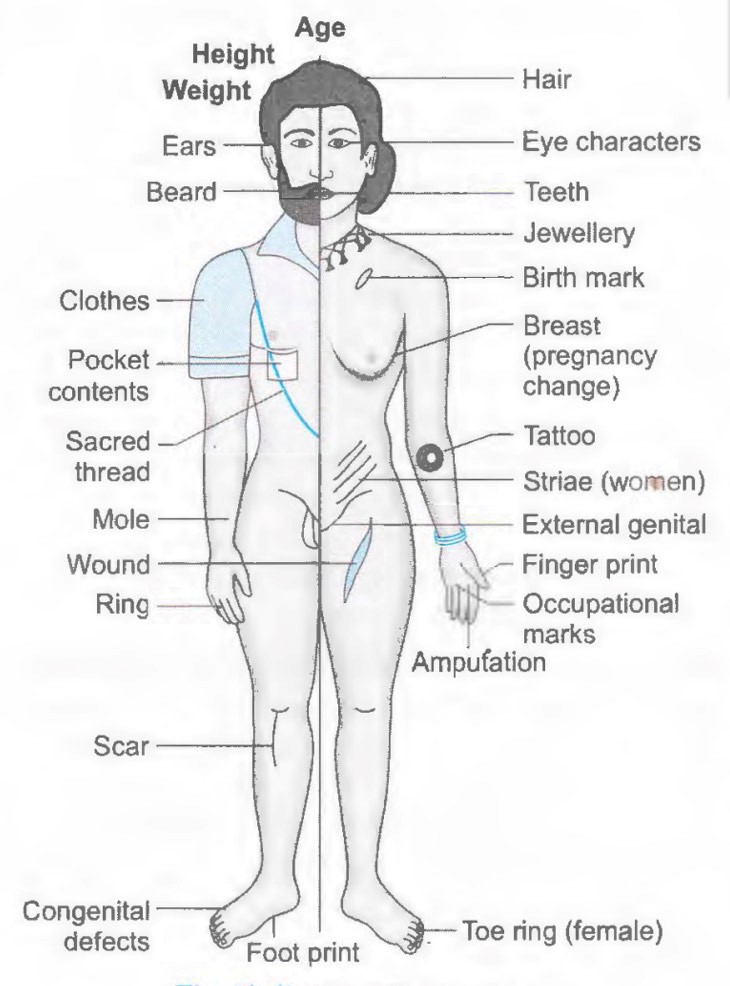
References
- Biswas Gautam. Review of forensic medicine and toxicology, 2nd edition (2012). Jaypee brother’s medical publishers, New Delhi.45-65.
- Reddy K S N. The essentials of Forensic Medicine & Toxicology, 12th edition, (1990), K. suguna baby. Hyderabad, 41-73.
- Parikh C K. Parikh’s Textbook of Medical Jurisprudence, forensic medicine and toxicology, sixth edition reprint (2012). CBS publishers & Distributors pvt Ltd, New Delhi.2.1-2.21.
- Subrahmanyam, B V. Parikh’s Textbook of Medical Jurisprudence, forensic medicine and toxicology, eighth edition (2019). CBS publishers & Distributors pvt Ltd, New Delhi.59-77.
- Biswas Gautam. Review of forensic medicine and toxicology, 3nd edition (2015). Jaypee brother’s medical publishers, New Delhi. 84-96.
- Franklin C A. Modi’s Medical jurisprudence & toxicology, 21st edition, reprint (1990), N.M. Tripathi private limited. 28-67.
- Subrahmanyam BV Modi’s Medical jurisprudence & toxicology, 22 edition, (1999), Butterwort5h’s, 37-88.
- Kumar Ajay. Text book of forensic medicine & toxicology, 2nd edition (2016). Avichal Publishing Company, sirmour H.P.61-100.
- Malik C C. Short Text of Medical jurisprudence. 2nd edition, (1984). The new book stalls Kolkata.40-123.
- Nandy Apurba. Hand book of Medical Jurisprudence. 2nd edition, reprint (2017) new central book agency pvt Ltd. Kolkata.48-111.
- Biswas Gautam. Review of forensic medicine and toxicology, 4th edition (2019). Jaypee brother’s medical publishers, New Delhi.61-86.



